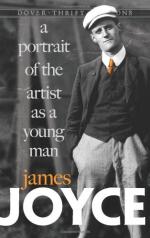|
|
A Portrait of the Artist as a Young Man Topic Tracking: The Artist
Part 1
The Artist 1: Stephen shows some early signs of artistic temperament, including his tendency to associate things he sees with what he's read in books. He also has a wandering mind that is often led astray by beautiful sounds or things, as in "White roses and red roses: those were beautiful colors to think of" (pg. 9).
The Artist 2: If the ability to be rebellious for what you believe in is a necessary quality of an artist, Stephen shows a bit of this by telling on the prefect. His resolution to be "quiet and obedient" (pg. 61) with the prefect, however, indicates that authority still has a strong pull on him.
Part 2
The Artist 3: At Blackrock, Stephen feels more alienated--he isn't particularly moved by Uncle Charles' religious devotion and he mistrusts Mike Flynn. It is The Count of Monte Cristo, a work of literature, rather than the people around him that interests Stephen most.
The Artist 4: Like the characters in The Count of Monte Cristo, the characters Stephen sees on the streets of Dublin stimulate his imagination. Stephen's imaginative life is blossoming.
The Artist 5: Stephen's thoughts as he tries to compose the poem to Emma give the first hint of his aesthetic sensibilities, suggesting how he will create art if he does become an artist.
The Artist 6: Stephen increasingly feels the pull of "intangible phantoms" (pg. 88), phantoms that presumably include the ambition to be an artist. But the pull to be a gentleman and a good Catholic threaten to keep him from a life devoted to art.
The Artist 7: The fragment from a Shelly poem on pg. 102 suggests that weariness may await the artist who forsakes companions and daily pleasures in pursuit of art. This concept of "weariness" is mentioned often, sometimes suggesting that weariness befalls the artist, other times that to not have art in one's life is what leads to weariness.
Part 3
The Artist 8: Even as Stephen is walking to confession, the physical world competes for his attention with more heavenly thoughts. If indeed a fascination with the physical world, with "the common accents, the burning gasjets in the shops, odours of fish and spirits and wet sawdust, moving men and women" (pg. 152), is what makes an artist, it seems right to say that Stephen has an artistic temperament.
Part 4
The Artist 9: In the process of making his decision to turn away from a life devoted to God, Stephen finds himself thinking about words. His thoughts on p. 180 about what it is he loves about words suggest that he's already beginning to try and nail down his philosophy of art.
Part 5
The Artist 10: At the university, Stephen is thought of by his classmates and teachers as a poet, or at least a poet-in-training. So at this point his public image is that of an artist.
The Artist 11: Stephen finally completes his first poem. The poem is pretty, though not spectacular. It is a bit of a relief, at any rate, that he's finally gotten beyond just talking about art and into the business of trying to create some.
The Artist 12: By the end of the novel, Stephen has resolved in his mind that he will choose the life of the artist, regardless of the exile and loneliness he may have to suffer because of this decision.




